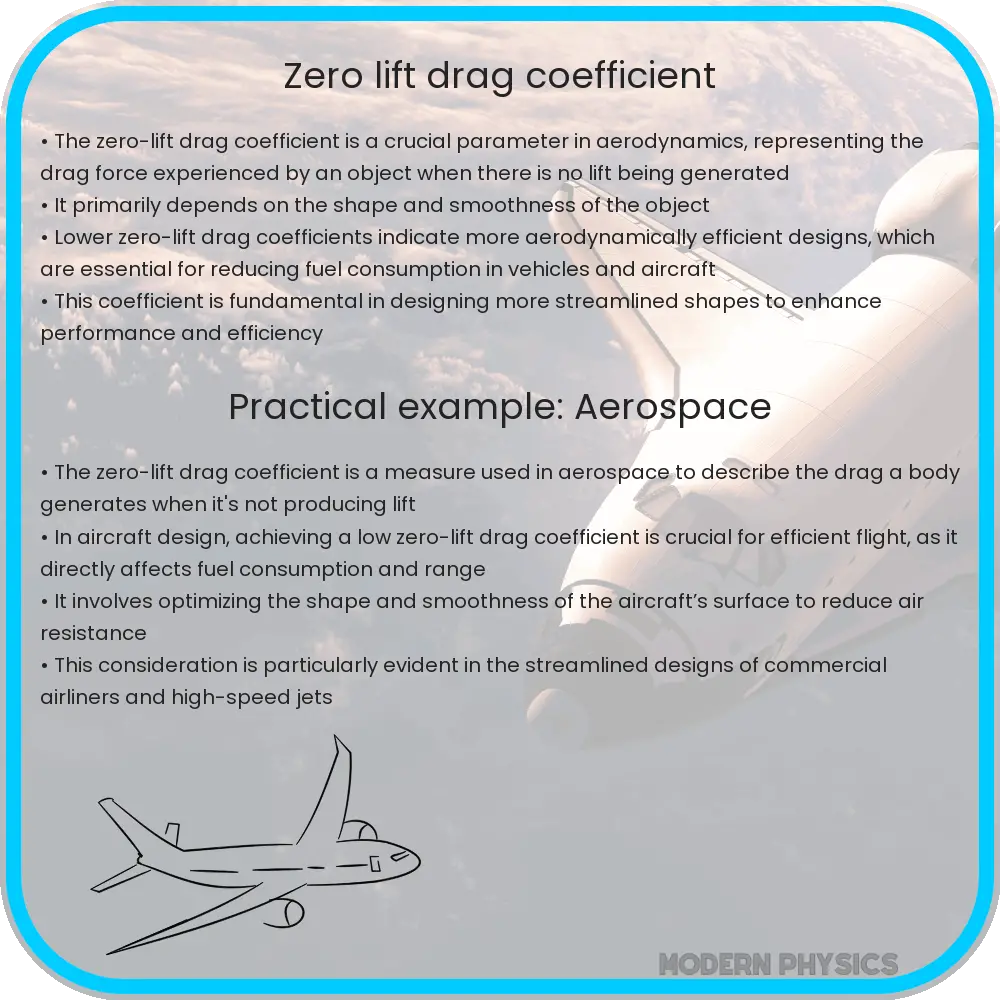Learn about the zero-lift drag coefficient (CD,0), a crucial parameter in hydrodynamics for optimizing the design and efficiency of vehicles like ships and submarines without lift.

Understanding the Zero-Lift Drag Coefficient in Hydrodynamics
The concept of the zero-lift drag coefficient, denoted as CD,0, is crucial in the field of hydrodynamics and aerodynamics for analyzing the drag performance of bodies like ships, submarines, aircraft, and cars when these bodies are not producing lift. This coefficient is a fundamental determinant in the study of fluid dynamics as it impacts the efficiency and design of various marine and aerial vehicles.
The Basics of Drag in Fluid Dynamics
Drag is the resistance a body experiences as it moves through a fluid (like air or water). This resistance force acts opposite to the direction of the moving object and is influenced by factors such as the shape of the body, the viscosity, and density of the fluid, and the velocity of the object. In hydrodynamics, understanding and minimizing drag is essential for designing more efficient vehicles that operate in aquatic environments.
What is Zero-Lift Drag Coefficient?
The zero-lift drag coefficient, CD,0, is specifically used to quantify the drag force experienced by a body, independent of the lift forces. This measure is crucial especially in designing scenarios where the lift is deliberately zeroed, such as in neutral buoyancy in submarines, or in streamlined vehicles designed primarily for speed and minimal resistance rather than altitude.
- Formula: The drag force D can be expressed generally by the equation D = 0.5 * ρ * V2 * A * CD, where:
- ρ (rho) is the fluid density,
- V is the velocity of the body relative to the fluid,
- A is the reference area, and
- CD is the drag coefficient.
At zero lift, the lift-dependent part of the drag coefficient is negligible, so the equation simplifies to focus on CD,0.
- Importance in design: For engineers, knowing CD,0 allows for more accurate predictions of fuel consumption, power requirements, and overall vehicle performance under non-lifting conditions.
Examples in Application
Consider the design of racing yachts or high-speed underwater drones; these devices often operate under conditions where lift is minimized to reduce drag as much as possible. Here, a thorough understanding of CD,0 facilitates the design of hull shapes that are optimized for speed by reducing adverse hydrodynamic effects.
Another prime example is found in the automotive industry, particularly in the design of electric cars, where efficiency is paramount. Low CD,0 values are desirable to extend the vehicle’s range by cutting down on the energy required to overcome air resistance.
Role of Computational Simulations
Advances in technology now allow engineers to use computational fluid dynamics (CFD) simulations to calculate and visualize the zero-lift drag coefficient more accurately. This computer-based modeling helps in predicting how changes in design affect CD,0. For instance, altering the shape of a submarine’s hull can be visualized in a simulation to understand its impact on drag, without the need for expensive and time-consuming physical prototypes.
Challenges in Practical Measurements
Measuring CD,0 in real-world scenarios presents challenges, primarily due to environmental variables such as wind gusts or water currents, which can alter drag readings. Engineers often rely on controlled experimental setups or correction factors in their calculations to approximate real-world conditions as closely as possible.
Future Directions
The ongoing research in materials science and design optimization continues to push the boundaries of what is possible in reducing zero-lift drag coefficients. Innovations like new composite materials or AI-driven design algorithms offer potential ways to achieve even lower CD,0 values, enhancing environmental sustainability and operational efficiency of vehicles.
Conclusion
In summation, the zero-lift drag coefficient, CD,0, is a pivotal factor in the design and operation of various vehicles within aerodynamics and hydrodynamics. Understanding this coefficient not only supports the development of faster, more efficient vehicles but also impacts their environmental footprint by reducing energy consumption. As technology continues to advance, the precise calculation and optimization of CD,0 will remain a central focus in fluid dynamics research, driving innovation in vehicle design across multiple industries. The blend of theoretical knowledge with practical application and technological tools like CFD ensures continuous improvement in our ability to tackle drag-related challenges head-on.
